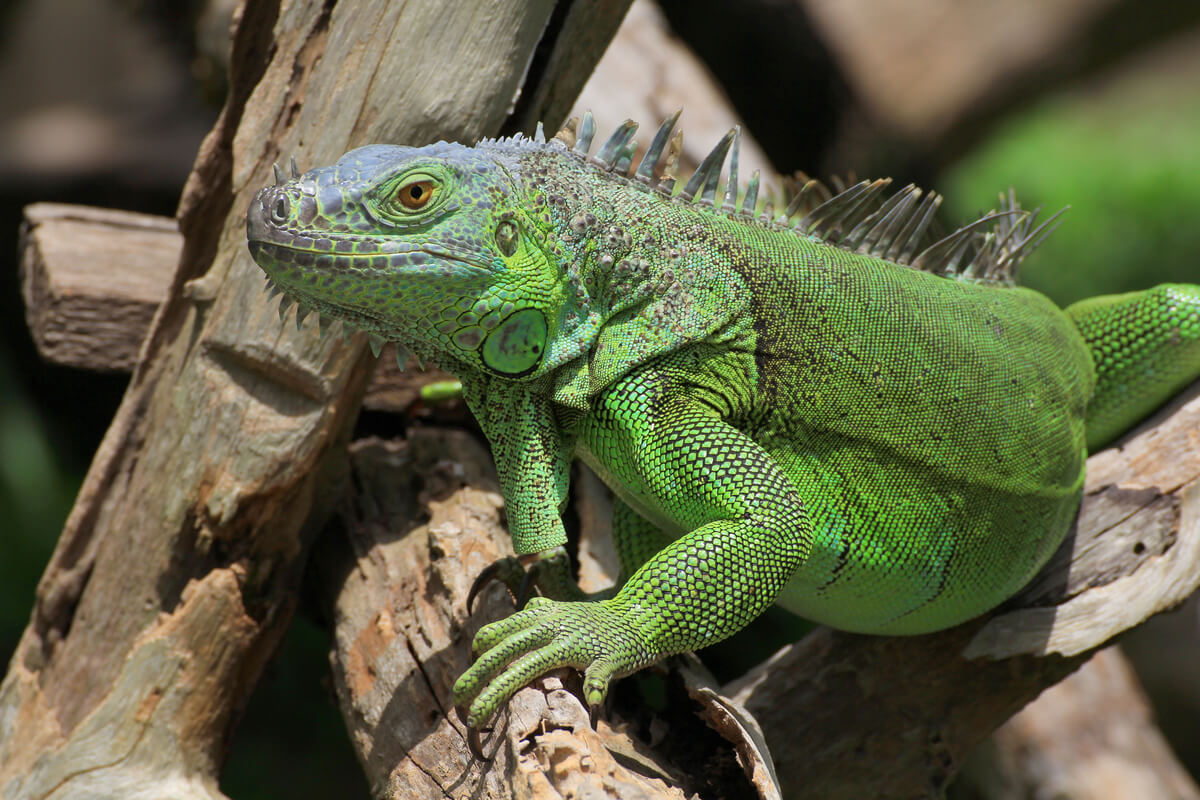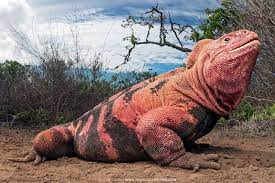14 Types of Iguanas


Written and verified by the biologist Cesar Paul Gonzalez Gonzalez
Iguanas are characterized by a robust and elongated body that can reach imposing sizes. Each species is unique and can range from terrestrial species to some arboreal ones. In addition, they inhabit the tropical climates of the American continent and certain specimens have become peculiar pets for humans. All these reptiles are grouped in the Iguanidae family and are subdivided into 8 genera. These small subgroups have their own particular characteristics that make them unique. Continue reading this article and discover the different types of iguanas.
Types of iguanas
Iguanas are very similar to lizards, only with a larger size and a more robust body. For the most part, they’re a group of terrestrial reptiles that use the daytime for their activities, as they’re “cold-blooded” and need the sun’s heat. There are about 40 species grouped in the following genera:
- Amblyrhynchus: 1 species in the Galapagos Islands.
- Brachylophus: 4 species, Fiji and Tonga islands.
- Conolophus: 3 species, Galapagos Islands.
- Ctenosaura: 15 species between Mexico and Central America.
- Dipsosaurus: 1 species in the southern United States and northern Mexico.
- Sauromalus: 5 species, North America and some nearby islands.
- Cyrclura: 10 species, Caribbean (West Indies and the Bahamas).
- Iguana: 2 species in America and the Caribbean.
There’s a conflict with the classification of some organisms, so in the future they’re likely to either increase or decrease in number. Even so, iguanas are the type of reptiles with the best distribution and they have even reached insular habitats (islands). Some of the most representative species of the group are the following.
1. Green Iguana (Iguana iguana)
This lizard has arboreal habits and reaches sizes of almost 2 meters (6.6 feet) in length. It usually lives in tropical rainforests and in some mangrove swamps, although it’s also able to survive in arid and semi-arid regions. They also exhibit a beautiful dorsal crest that runs along their entire back and a dewlap-like fold of skin under their snout.

2. Lesser Antillean Iguana (Iguana delicatissima)
The Caribbean iguana is an arboreal species and shares many of its physical characteristics with the green iguana, but its coloration changes according to where it lives. These types of iguanas are distributed in the forests, jungles, and mangroves of the Lesser Antilles.
3. Fiji Crested Iguana (Brachylophus vitiensis)
This reptile is endemic to the dry forests found in the Fiji Islands. They measure about 70 centimeters in length (2.3 feet) and have light green coloration with white markings. They have a fold of skin under their snout, but their crest isn’t as prominent as in other iguana species.
4. Lau banded iguana (Brachylophus fasciatus)
The Lau banded iguana originates from the Lau islands east of the Fijian archipelago, although it has also been introduced to Tonga by man. It’s distinguished by its green coloration with a series of white bands along its body. It’s considered a national treasure by the Fijian government and is even kept as a symbol on postcards, coins, and books.
5. Brachylophus bulabula
This species was only recently discovered – in 2008. Its population was classified as a banded iguana due to its great physical similarity, but thanks to molecular analysis it was reclassified as a distinct species. In addition, it lives almost exclusively in the rainforests of Ovalau, Kadavu, and Viti Levu islands.
6. Conolophus pallidus
This iguana has a pale yellow coloration with well-defined dorsal spines (crest). It can reach sizes of approximately one meter (3.3 feet) in length, with a bodyweight of 11 kilograms (24 lbs). It has the habit of warming its body by lying on volcanic rocks. It’s endemic to Santa Fe Island in the Galapagos archipelago.
7. Galapagos Land Iguana (Conolophus subcristatus)
These land iguanas usually live on islands that don’t have any fresh water, and so they tend to eat cactus, fruits, and flowers to try to obtain liquids and not become dehydrated. Their size can vary between 90 and 150 centimeters (35 to 60 inches) long, depending on the island they come from.
8. Conolophus marthae
This peculiar pink iguana is endemic to Isabela Island. It was discovered in the vicinity of Wolf Volcano, an area that’s difficult for humans to access. It’s estimated that there are less than 200 of them left in the region, so it’s considered a critically endangered species.

9. Spiny-tailed iguana (Ctenosaura pectinata)
The spiny-tailed iguana inhabits western and central Mexico. Specifically, it lives in the humid areas near the coasts where jungle ecosystems abound. It can reach 1.2 meters (nearly 4 feet) in length and weighs just over 9 kilograms (20 lbs). Due to its size and abundance, since pre-Hispanic times it has been used as a source of meat.
10. Utila Spiny-tailed Iguana (Ctenosaura bakeri)
This species is endemic to the province of Utila in Honduras. It lives in the mangroves of the region and is characterized by being an opportunistic hunter. In addition, it exhibits a dark coloration from birth to maturity, changing to blue or gray shades when it becomes an adult.
11. Desert Iguana (Dipsosaurus dorsalis)
The desert iguana is distributed throughout the deserts of northern Mexico and the southern United States. It’s one of the most common lizards in the area and is characterized by a dorsal band full of spiny scales. Its body reaches 60 centimeters (2 feet) in length and it exhibits a combination of gray, brown and white coloration.
12. Common Chuckwalla (Sauromalus ater)
These types of iguanas are characterized by having an elongated, robust, and flat body. They’re about 40 centimeters (1.3 feet) long and weigh about 1 kilogram (2.2 lbs). They can be seen in the deserts of southern North America, between Mexico and the United States. Chuckwallas are known for their curious ability to hide inside rock crevices, where they inflate their bodies to create pressure and avoid being pulled out.
13. Rhinoceros Iguana (Cyclura cornuta)
The rhinoceros iguana is endemic to the island of Hispaniola in the Caribbean Sea. It has received its name due to the three horns on the upper part of its snout. It’s about 1.10 meters (3.6 feet) long and weighs up to 5 kilograms (11 lbs). Its body has gray and dark green colorations combined with brown tones. It also has a flattened tail that can serve as a whip to defend itself from aggressors.
14. Marine iguana (Amblyrhynchus cristatus)
This species can only be found on the rocky coasts of the Galapagos Islands, although they also inhabit some mangrove swamps and, in a few cases, beaches. Among the different types of iguanas, they’re the only ones that need the sea to survive, as they feed on seaweed. However, they don’t usually swim to get their food, but wait for the tide to go out so that the seaweed remains on the sand.
As you can see, there are many different types of iguanas. Each with its own distinctive characteristics and unique distribution, which even includes some islands. Despite their ungraceful shape, it’s obvious that they have a great adaptive capacity and different incredible innate abilities.
All cited sources were thoroughly reviewed by our team to ensure their quality, reliability, currency, and validity. The bibliography of this article was considered reliable and of academic or scientific accuracy.
- Gentile, G. 2012. Conolophus marthae. The IUCN Red List of Threatened Species 2012: e.T174472A1414375. https://dx.doi.org/10.2305/IUCN.UK.2012-1.RLTS.T174472A1414375.en.
- Fisher, R. N., Niukula, J., Watling, D., & Harlow, P. S. (2017). A new species of iguana Brachylophus Cuvier 1829 (Sauria: Iguania: Iguanidae) from Gau Island, Fiji Islands. Zootaxa, 4273(3), 407-422.
- Keogh, J. S., Edwards, D. L., Fisher, R. N., & Harlow, P. S. (2008). Molecular and morphological analysis of the critically endangered Fijian iguanas reveals cryptic diversity and a complex biogeographic history. Philosophical Transactions of the Royal Society B: Biological Sciences, 363(1508), 3413-3426.
- Schulte, J. A., Valladares, J. P., & Larson, A. (2003). Phylogenetic relationships within Iguanidae inferred using molecular and morphological data and a phylogenetic taxonomy of iguanian lizards. Herpetologica, 59(3), 399-419.
- Lobo, F., Espinoza, R. E., & Quinteros, S. (2010). A critical review and systematic discussion of recent classification proposals for liolaemid lizards. Zootaxa, 2549(1), 1-30.
- Canseco-Márquez, L. & Gutiérrez-Mayén, G. (2010) Anfibios y Reptiles
del Valle de Tehuacán-Cuicatlán. CONABIO: México.
This text is provided for informational purposes only and does not replace consultation with a professional. If in doubt, consult your specialist.







